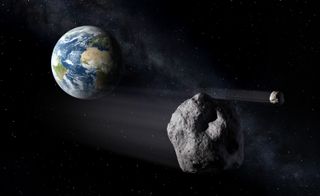Search for Dangerous Asteroids Gets NASA Funding Boost

A NASA-sponsored program that scans the cosmos for potentially dangerous asteroids is being upgraded to improve its ability to hunt for space rocks that might collide with Earth.
NASA is doling out a new $4.1 million grant for the Catalina Sky Survey (CSS), which is based at the University of Arizona in Tucson. The funds will be used to upgrade and operate the program's telescopes through 2015. The project monitors the skies for new comets and asteroids, including potentially dangerous near-Earth objects (NEOs) — hazardous space rocks that threaten to cross the Earth's path someday.
"NASA has recognized that over the last seven years, our program has constantly strived to improve its performance, and has collaborated with others to find new ways to exploit the nearly 1,000 images we take every night with our two telescopes in the mountains north of Tucson," Edward Beshore, principal investigator of the Catalina Sky Survey, said in a statement. "I think NASA recognizes the CSS as a valuable service to, well, humanity."
In 2011, the survey uncovered 586 near-Earth asteroids, which was 65 percent of the total NEO discoveries for the year. The CSS team was also the first to observe an asteroid on a collision course with Earth, which enabled researchers to track the path of the space rock and eventually locate meteorites that reached the ground in Northern Sudan.
The new grant money will be used to expand the power of the project's largest telescope, develop more sensitive software, and conduct searches on more nights every month, CSS officials said in a statement. [Photos: Asteroids in Deep Space]
The Catalina Sky Survey utilizes two wide-field survey telescopes and a dedicated follow-up telescope located in the Catalina mountains north of Tucson. To detect NEOs, the team uses the two telescopes to take four images of selected portions of the sky roughly 10 minutes apart from one another.
Special software is then used to comb through the data to look for faint objects that appear to be moving across the sky in a straight line. Filters are applied to remove known asteroids and false detections. The results are then presented to an observer for verification. If an asteroid is suspected to qualify as an NEO, it is reported to the Smithsonian Institution in Washington, D.C. for follow-up studies and analysis.
Get the Space.com Newsletter
Breaking space news, the latest updates on rocket launches, skywatching events and more!
Part of the new funds from NASA will be used to upgrade the camera on the 1.5-meter telescope on the summit of Mt. Lemmon, enabling the observatory to cover more of the sky.
"When we began observing in 2000, our image sensor was 16 megapixels, which was large by any standard," CSS co-investigator Steve Larson said in a statement. "Today, commonly available consumer digital cameras have surpassed that size, and we were reaching the limit of productivity with our current camera design."
The new camera system is expected to increase the amount of sky the telescope can cover each month by four times.
"We believe this will translate into a nearly proportional increase in the number of discoveries we make each month," Larson said.
The Catalina Sky Survey also spawned a spinoff project, called the Catalina Realtime Transient Survey, which uses the data to make observations of objects and events beyond just the search for asteroids.
"We image the entire sky every month with our telescope on Mt. Bigelow in partnership with colleagues at Caltech who had developed software to search for changes in the stationary cosmic objects," Beshore said. "Almost as fast as we can acquire the data, they are able to detect changes in the brightness of stars and galaxies that can reveal important clues about objects millions of times farther away than the asteroids we search for."
Follow SPACE.com for the latest in space science and exploration news on Twitter @Spacedotcom and on Facebook.
Join our Space Forums to keep talking space on the latest missions, night sky and more! And if you have a news tip, correction or comment, let us know at: community@space.com.

Space.com is the premier source of space exploration, innovation and astronomy news, chronicling (and celebrating) humanity's ongoing expansion across the final frontier. Originally founded in 1999, Space.com is, and always has been, the passion of writers and editors who are space fans and also trained journalists. Our current news team consists of Editor-in-Chief Tariq Malik; Editor Hanneke Weitering, Senior Space Writer Mike Wall; Senior Writer Meghan Bartels; Senior Writer Chelsea Gohd, Senior Writer Tereza Pultarova and Staff Writer Alexander Cox, focusing on e-commerce. Senior Producer Steve Spaleta oversees our space videos, with Diana Whitcroft as our Social Media Editor.
